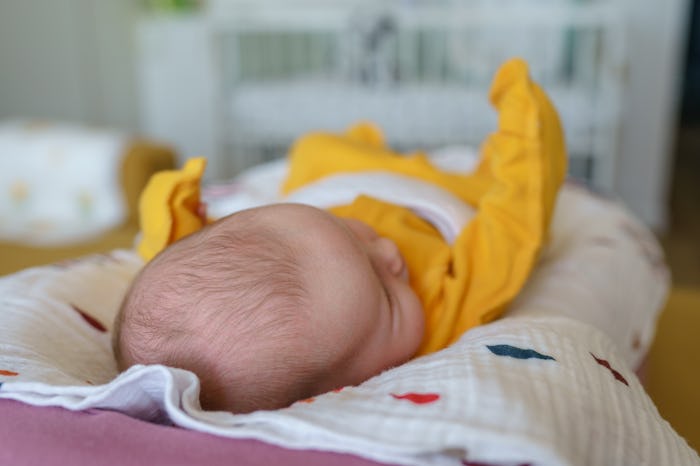Parenting

Here’s When Your Baby’s Soft Spot Will Close & Finally Stop Pulsing
It’s unsettling, tbh.
Newborns do so many magical little things, like smile when they fall asleep and scrunch up when you lift them from their crib. They can also do some pretty weird stuff, like randomly shake all over (which is not a reason to panic, it turns out). So if you glance down at your newborn and see their scalp pulsing, it’s natural to be alarmed and concerned about your baby’s still-developing soft scalp. Here’s why your baby’s scalp pulsates and when you can expect it to stop.
Spoiler: The soft spots (yes, there’s more than one) play an important role in your baby’s birth and brain development, so it’ll be a while before they’re totally closed.
Why do babies have a soft spot?
The human skull is made up of eight bones, and a newborn’s skull isn’t yet fused together the way an adult’s is. Also known as a fontanelle, the anterior soft spot is that little area near the front of your newborn’s head where the bones aren’t yet touching. As a result, there’s no hard bone beneath it, just soft skin and tissue. Newborns also have a posterior fontanelle — a soft spot farther back on the head — that is smaller than the one up front.
Together, these soft spots make your baby’s skull flexible enough to squeeze through the birth canal (hence why they sometimes come out with a cone-shaped head after a vaginal delivery). Having skull bones that aren’t fused together also allows your baby’s cranium to adapt to how quickly their brains grow in the early years.
“You need those spaces because it allows for your baby’s brain inside to grow rapidly over the next two years,” says Dr. Nicola Chin, M.D., Children’s Healthcare of Atlanta pediatrician and associate professor of pediatrics at the Morehouse School of Medicine.
When will my baby’s soft spots close?
The anterior soft spot typically closes around 18 months of age, Chin says (but it can start shrinking as early as 7 months). The posterior fontanelle closes much sooner, around 2 or 3 months of age, according to Chin. She adds that if your baby’s soft spots are closing way before those timeframes, or haven’t closed around when they should, bring it up with your child’s doctor.
What is the soft spot baby’s head closes too early?
You might want it to go away already, but it’s actually important that your little’s fontanel doesn’t close far ahead of schedule. “We do have concern if they close way too early, especially the anterior fontanel, as it may indicate that the skull is fusing too early,” says Chin. “There are medical conditions that we would be concerned about.”
Your pediatrician will check your baby’s fontanelles at their regularly scheduled check-ups to ensure they’re closing normally, but if you have specific concerns, don’t hesitate to bring them up.
What happens if a baby’s soft spot doesn’t close?
Even if your little one’s fontanelle isn’t totally closed by 18 months, Chin says not to panic. “Don’t be alarmed; they will close over time. I’ve never had a baby’s not close over time. We will still track it and most are closed by 2 years of age.”
If your toddler still has a soft spot that isn’t closing, your doctor may start testing them for certain health conditions. For example, congenital hypothyroidism is known to cause fontanelles to remain open.
Why does my baby’s soft spot pulse?
Admittedly, it’s kind of freaky, right? Seeing your baby’s brain pulsate feels a little bit sci-fi and weird, but it’s totally normal.
“Some parents come in and they’re like, ‘Oh my gosh, it’s beating at the top and it’s pulsating.’ This is not unusual because, remember, there’s no skull covering, so you actually have that gel fiber layer, but you can see the pulsating of the blood vessels that are under there. It corresponds to the baby’s heartbeat and the pulsing of blood throughout the body,” Chin says.
You may even notice your baby’s soft spot pulses more when they’re upset, but Chin say that’s just a result of their blood pumping a little faster.
Can you brush over a baby’s soft spot? What about shampooing at bath time?
Knowing that your baby essentially has a gap in their skull — and that their growing brain is underneath it — makes you feel like you should be handling them with greater care than you already are. Fear not: you don’t have to forego gentle activities, like washing and brushing their hair, says Dr. Chin.
“You don’t have to be afraid about those soft spots because they’re covered by a thick, fibrous gel layer,” she says. “Brushing and lightly combing are all acceptable activities of daily living that can be performed with the baby. You can touch it; I have to touch it as a pediatrician to explore the size as the baby grows throughout the year, because they do have to close at some point.”
So, soft spots are kind of weird, but they serve a really important purpose for your baby. And if you have any questions about your baby’s fontanelles, your pediatrician will know how to answer them.
Expert:
Dr. Nicola Chin, M.D., Children’s Healthcare of Atlanta pediatrician and associate professor of pediatrics at the Morehouse School of Medicine
This article was originally published on